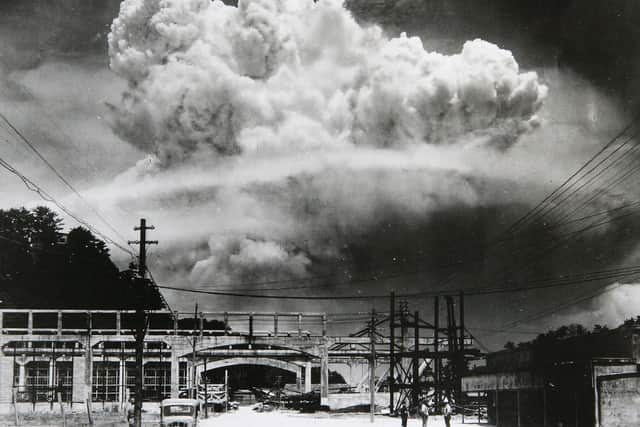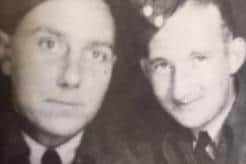The astonishing story of how a Yorkshire serviceman became a Japanese prisoner of war and survived atomic bombing of Nagasaki
RON Bryer didn’t talk much about what he had endured during three years as a prisoner of war of the Japanese. Only gradually did his family learn what he had gone through – and when they did, they could barely believe it.
That is because Ron was one of the luckiest people in the world. At just after 11am on August 9 1945, he survived the atomic bombing of Nagasaki, which killed 75,000 people.
Advertisement
Hide AdAdvertisement
Hide AdRon lived to bear witness, his only injuries cuts and bruises from a wall that collapsed on him, despite being only a mile from the epicentre of the most devastating blast in history, caused by an atomic bomb much more powerful than the one that had been dropped on Hiroshima three days before. He owed his life to being ordered into an air raid shelter to repair damage from a previous bombing.


“All around me were members of the prison camp, prisoners and guards alike, many injured, many with their clothes on fire, all moving aimlessly around with the same vacant look on their faces, as if their minds could not accept what their eyes could see.”
Ron’s astonishing survival is at the heart of a new book, Nagasaki: The Forgotten Prisoners, by John Willis, which tells the story of allied prisoners of war used as forced labourers in the shipyards and foundries of the port city that was one of Japan’s industrial powerhouses. His book has been 38 years in the making. John first heard Ron’s story from his son, Chris Bryer, in 1984 when both were working at Yorkshire Television, in Leeds. John and Chris took Ron and his friend and fellow-survivor, Arthur Christie, from London, back to Nagasaki for a critically-acclaimed documentary.
Yet in the intervening years, the story of the group of prisoners held in Nagasaki after being captured all over the Far East when the Japanese overran allied territories in 1941-42 has been largely forgotten, even though the atomic bombings of Japan were pivotal moments in human history, the horror of which has acted as a deterrent against the use of nuclear weapons ever since. John says: “This has been airbrushed out of the mainstream. There is relatively little known about these men, so I started to dig around and I realised that very little has been published.”


Advertisement
Hide AdAdvertisement
Hide AdEven before the bombing, Ron’s wartime story was hair-raising. He was born in Follifoot, near Harrogate, and joined the RAF aged 20, in 1941, being trained as a high-speed telegraph operator and posted to Singapore just as the territory was coming under attack. When it fell, he escaped with his unit to Java, where he was captured in early 1942 by a Japanese officer who stuck a gun in his face and appeared about to execute him. Starvation, beatings and forced labour followed before Ron was amongst prisoners transported to Japan in September 1943 aboard what became known as “hell ships” for their overcrowded, insanitary conditions.
He contracted dysentery, and by the time of the nuclear strike, Ron’s weight was down to a skeletal seven stone – half what it had been when he was taken prisoner. But Ron was a survivor, stealing food to keep going and refusing to be ground down by the brutality of his captors. John says: “I think he was hard-wired to survive. Survival was a matter of luck, but he had physical strength and skill. He came from a large family of 10 kids, he’d done a lot of sharp-elbowing to survive, a bit of poaching on the side, and at the same time he was very clever. He’d attended Harrogate Grammar School. He had a personality that was rock solid. He was the man that people turned to as the reliable one. If anyone was going to survive, it would have been Ron.”
But when Ron came home, marrying his wife, Pat, and living in Settle where he was chief engineer at a dairy, their three children only discovered very slowly what he had been through because he was reluctant to talk.
Chris Bryer said: “We heard little fragments as kids. A lot of servicemen returning from war don’t talk about what they experienced and my dad didn’t, but he told us a few stories and gradually over time as we grew up that built into a fuller picture, until it became clearer. The full details of the story began to emerge, and most incredibly the survival from this atom bomb. Most of my time growing up, he never said anything to me about his own personal response to what had happened.”


Advertisement
Hide AdAdvertisement
Hide AdAs he grew older, Ron became more forthcoming, eventually publishing a memoir, The White Ghosts of Nagasaki, in 1997 and giving talks, including to students at Giggleswick School. Chris says: “He began to devote a lot of time to writing down his memories, probably every day and he also began giving talks. He became very much sought after as a speaker in our area of the Dales, and at the same time he was working on writing this book. It must have been a cathartic experience.”
And unlike many former prisoners of war who never forgave Japan for the suffering inflicted on them, Ron harboured no bitterness, starting to exchange letters with people in Nagasaki. Chris adds: “He explicitly said he didn’t blame the Japanese people at all for this. He saw it as a result of the war, which the Japanese people had no hand in, and the abuse he and other prisoners suffered he saw as the fault of the Japanese military. I really don’t think he harboured negative reactions.”
“They eventually straggled home not far off Christmas in 1945. VE Day had been six months before and people had just picked up the threads of normal life. They had celebrated, got married, started jobs again and suddenly these skeletal men came off boats at Southampton and people didn’t know what to say or what to do, or how to treat them. And the men didn’t know what to say either, and the combination of those things made them feel forgotten.
“It is about our duty to remember. If we are going to learn lessons from the war, it’s important that we keep the flame alive and keep these remarkable stories at the forefront of public attention.”
Nagasaki: The Forgotten Prisoners is out now from Mensch Publishing.
